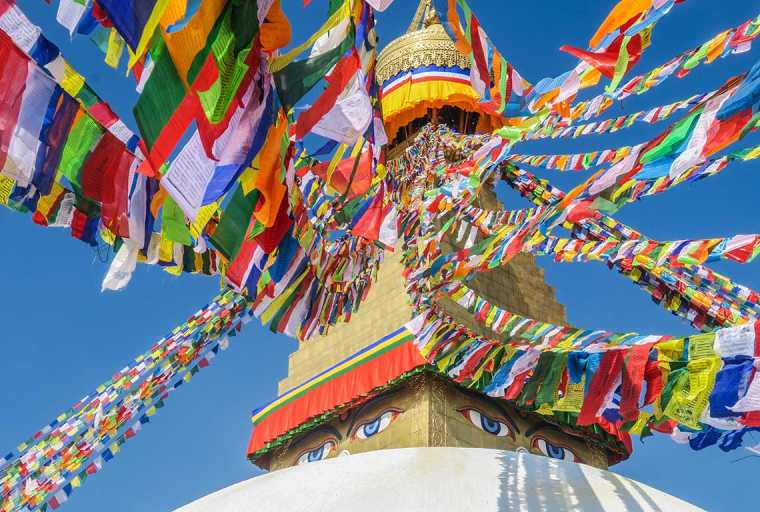Day 01: Arrival in Kathmandu at the altitude of 1,350m/4,428 feet.
Upon your arrival at the Tribhuvan International Airport of Kathmandu you will be welcomed by one of our representative from Redrose Travel who will drive you to the respective hotel. Later in evening the Redrose Travel will be hosting a welcome dinner in one of the best Nepali restaurants of Kathmandu which serves you delectable Nepali cuisine with seasonal vegetables and many more. We will spend our night in Kathmandu hotel rating at two or three star hotel.
Dinner is included.
Day 02: Sightseeing Kathmandu and trip preparation
Today on second day after breakfast we will began our trip where we will be touring some of the historical heritage sites of Kathmandu which is listed in UNESCO world heritage sites of Kathmandu. Firstly we will began with ancient historic Durbar Square where the earlier king used to reign over this country- Nepal and now this Durbar- Palace has turned into a museum where you get to explore pre historic king dynasty and many more and surrounding the square there are some temples which showcases ancient arts and architecture. Next will be sacred site named Pashupatinath temple which is the oldest and one of the holiest shrine of Hindus and even this site is also the place for cremation site of Hindus and after that we will head to Swambhunath temple which is positioned at the hillock and simply this temple is known as monkey temple. After that we will head to Boudhanath Stupa which is holiest shrine of Buddhists where you will get to observe more than 50 monasteries surrounding the stupa where you will find Buddhists devotees doing Kora- pilgrimage round around the stupa. Later after touring we will head to Redrose Travel office where we will be introducing you to other fellow participants who will be joining you along and our experts will check all the climbing equipment’s. We will spend our night in Kathmandu in same hotel.
Breakfast is included.
Day 03: Fly toward Lukla {2,800m/9,184ft} then trek towards Phakding {2,652m/8,700ft}: 40 min flight, 3-4 hours trek
On the third day of our journey we will drive towards the airport and take a flight to Lukla. During our flight over stunning hills and breathtaking snowcapped peaks and within 40 minutes scenic flight we will reach at Lukla airport. We will be meeting our other crew members in Lukla and from there we will commence our trek towards Phakding, today we will be trekking only for few hours so that we are well adapted to the altitude. We will spend our night in Phakding.
Breakfast, Lunch and Dinner are included.
Day 04: Phakding toward Namche Bazaar [3,440m/11,283ft]: 5-6 hrs.
Today after having our breakfast we will continue our trek where our path passes via lush pine forests as well as also trek along with the Dudh Koshi River. With few hours of trekking we will getting the glimpse of mount Thamserku which is at the altitude of 6608 meter and continuing trekking via thick juniper, fir and pine forests and then we will cross the suspension bridge and then we will arrive at the main town of Sherpa people named Namche Bazaar. We will spend our night in Namche Bazaar.
Breakfast, lunch and dinner are included.
Day 05: Namche Bazaar {3,440 m/11,283 ft.}: acclimatization
Today is day kept aside for acclimatizing where we will just adapt the altitude but most health expert’s advice that instead of taking rest for full time we must do a short hiking where we will properly adapt the altitude. There are some option for short hike where you can either wander around the Namche Bazaar where you will come across Sherpa people and explore their culture and their lifestyles. We can even hike to Everest view hotel to capture the close view of Everest including with other several peaks on the way one can we will be also visiting local museum which display history of Everest region and diverse flora and fauna of Everest region.
Those who wish to hike for longer hours we can hike to Khumjung village which approximately take 5-6 hours where we will be visiting the Edmund Hillary School and also visit the famous Khumjung monastery where Yeti scalp is placed. We will spend our night in Namche Bazaar.
Breakfast, lunch and dinner are included.
Day 06: Namche Bazaar toward Debuche
Today we will be continue our trek to Everest trail where we will be passing by warm welcoming villages and then we will be crossing the Dudh Koshi River along with enjoying the mighty mountain Everest including with other peaks like Ama Dablam, Lhotse and Nuptse. After that we will ascend on steep trail and reaches at Tengboche monastery and then we will relax and spend some time exploring the monastery. After that we will descend down to Debuche where we will be spending our night.
Breakfast, lunch and dinner are provided.
Day 07: Debuche toward Pheriche [4,300m/14,107ft]: 5-6 hrs.
Today we will be hiking to Pangboche village on the way towards Pheriche. The village Pangboche is one of the beautiful village of the Everest region which is bounded by mighty mountain Everest and other peaks like Thamserku, Kangtaiga and Ama Dablam and the range of Kongde and the serene Imja river flowing via wide lush valley. We will continue our trek to Pheriche which is one of the stunning village where we will spend our night there at Pheriche.
Breakfast, lunch and dinner are included.
Day 08: Acclimatization
Today once again we will be acclimatizing the altitude which will help to minimize from suffering from altitude sickness. We will today ascend a terrain over Pheriche village which will be perfect for acclimating the altitude. We will be climbing uphill where we will be rewarded with stunning view of Himalayas. We will spend our night in Pheriche.
Breakfast, Lunch and Dinner are included.
Day 09: Pheriche toward Ama Dablam Base Camp {4570m/15000ft]: 5-6 hrs.
Today we will start our trek by hiking back towards Pangboche and then we will cross the Dudh Koshi River and then we will climb on the path which leads us to Ama Dablam base camp. The Ama Dablam base camp is the huge camp with ide grassland which is beneath the mount Ama Dablam. We will spend our night at Ama Dablam Base camp.
Breakfast, lunch and dinner are included.
Day 10: Acclimatization and Pre climbing training at Ama Dablam Base Camp
Today our climbing experts guide will be giving you a training how to summit the peak and how to use the climbing equipment’s like harness, climbing ropes, ice axe, crampons etc. This training will lift up your confidence and help in successfully summit the peak. We will spend our night in Ama Dablam base camp.
Breakfast, lunch and dinner are included.
Day 11-25: Ascending and Descending of Ama Dablam {6856m/22488ft}
Today from Ama Dablam base camp we will hike to camp 1 which is at 5,700 meter along the normal track. Before returning to base camp we will spend one night at camp for proper acclimatization and prepare for summiting the peak. There are total three camps before reaching the summit. The climb from base camp to camp I is technically challenging and from camp I we will be following the exiting fixed line and form a new rope anywhere required for ascend and descend. The climb from camp 2 towards camp 3 embraced of varied rock, ice and snow. The climb from camp 3 towards summit is comparatively less technical. With lots of effort summiting the peak we will be rewarded with great view of Himalayas. After enjoying spending some time in summit we will retrace back to Base camp.
Breakfast, lunch and dinner are included.
Day 26-27: Trek toward Lukla
We will trek back toward Lukla through Tengboche, Namche Bazaar and Phakding.
Breakfast, lunch and dinner are included.
Day 28: Fly back toward Kathmandu
Today early morning we will take a flight towards Kathmandu and reaching at the Kathmandu airport our guide will drop you at the hotel, you can relax and refreshed up. In evening the GHHT will be hosting a farewell dinner as well as also celebrate for successfully completing the expedition to Ama Dablam peak. We will spend our night in Kathmandu.
Breakfast and dinner are included.
Day 29: Leisure day in Kathmandu
This extra day is kept for any such unforeseen situation like delaying flight towards Lukla or any other situation might occur so, this extra day can be used it. If none of the above situation occurs then we can use this day’s by wandering around the Kathmandu city or you can do some souvenir shopping. We will spend our night in Kathmandu.
Breakfast is included.
Day 30: Final Departure
Today your adventure journey Ama Dablam peak climbing come to an end. Our representative from Redrose Travel will be dropping you at the airport three hours earlier than your flight schedule, on the way you can plan for your next adventure.
Breakfast is included.







